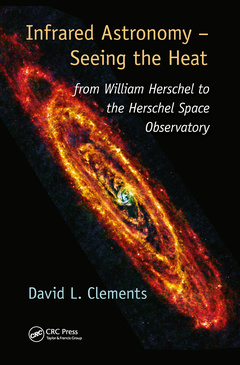Infrared Astronomy – Seeing the Heat from William Herschel to the Herschel Space Observatory
Auteur : Clements David L.

Uncover the Secrets of the Universe Hidden at Wavelengths beyond Our Optical Gaze
William Herschel?s discovery of infrared light in 1800 led to the development of astronomy at wavelengths other than the optical. Infrared Astronomy ? Seeing the Heat: from William Herschel to the Herschel Space Observatory explores the work in astronomy that relies on observations in the infrared. Author David L. Clements, a distinguished academic and science fiction writer, delves into how the universe works, from the planets in our own Solar System to the universe as a whole.
The book first presents the major telescopes in the world of observational infrared astronomy, explains how infrared light is detected through various kinds of telescopes, and describes practical problems that send infrared astronomers to the tops of mountains and their telescopes into orbit and beyond. Much of the book focuses on what infrared astronomers find in their observations. You?ll discover what infrared astronomy reveals about the planets, moons, and other bodies that constitute our Solar System; star formation and stellar evolution; the processes that shape galaxies; and dark energy and dark matter.
Infrared astronomy has revolutionized our understanding of the universe and has become essential in studying cosmology. Accessible to amateur astronomers, this book presents an overview of the science and technology associated with infrared astronomy. With color figures, it shows you how infrared astronomy provides insights into the workings of the universe that are unavailable at other wavelengths.
Finding the Heat. Feeling the Heat. Local Heat. Heat of the Stars. Young Heat. Distant Heat. Ancient Heat. First Heat. Future Heat.
Dr David L Clements is a Senior Lecturer in the Physics Department of Imperial College London. He has a degree in physics and a PhD in astrophysics from Imperial College. He has worked at Oxford University, The European Southern Observatory Headquarters, near Munich, the Institut d’Astrophysique Spatiale, near Paris, and at Cardiff University. His research is in the broad areas of extragalactic astronomy and observational cosmology, specialising in studies of dust in galaxies and the role that dusty galaxies play in galaxy formation and evolution. He has worked on the Herschel and Planck missions as Manager of the London Planck Analysis Centre, and head of the Herschel Data Processing and Science Analysis Software Centre London. As an infrared astronomer he has used data from all the major infrared satellite missions, from IRAS to Herschel, and many ground based telescopes. He is the author of over 200 scientific papers and also writes science fiction stories and popular science articles, which have been published in Analog, Nature Futures and Astronomy Now among others. His blog can be found at http://davecl.wordpress.com, which also hosts material associated with this book, and on twitter at @davecl42. This is his first book.
Date de parution : 03-2021
15.6x23.4 cm
Date de parution : 11-2014
Ouvrage de 290 p.
15.6x23.4 cm
Disponible chez l'éditeur (délai d'approvisionnement : 15 jours).
Prix indicatif 57,86 €
Ajouter au panierThèmes d’Infrared Astronomy – Seeing the Heat :
Mots-clés :
Herschel Space Observatory; Star Formation; William Herschel’s discovery of infrared light; Giant Molecular Clouds; processes that shape galaxies; Accretion Disk; observational infrared astronomy; Infrared Astronomy; star formation and stellar evolution; Protoplanetary Disk; detection of infrared light; Mauna Kea; dark energy and dark matter; CMB Anisotropy; science and technology of infrared astronomy; Hubble Deep Field; ground- and space-based telescopes; High Mass Star; Euclid mission; HII Region; European Extremely Large Telescope (E-ELT); Star Formation Rate; Atacama Large Millimetre Array (ALMA); Oort Cloud; Solar System; Infrared Astronomy Satellite (IRAS); Primary Mirror; Planck Surveyor; Big Bang; SMBH; Brown Dwarfs; High Redshift; Elliptical Galaxies; Active Galactic Nuclei; CMB Power Spectrum; Spiral Galaxies; Hot Jupiters; Low Mass Stars



